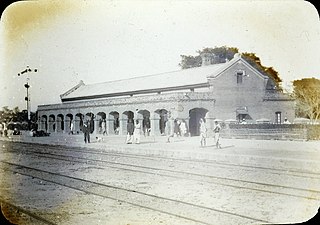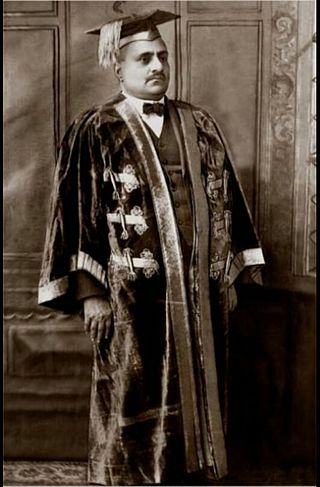
Raja Bahadur Kirtyanand Sinha (1880-1938) was an Indian businessman and philanthropist. [1]

Raja Bahadur Kirtyanand Sinha (1880-1938) was an Indian businessman and philanthropist. [1]
Sinha contributed to the establishment of T.N.B College in Bhagalpur, which was in need of funds, having been established in the 1880s.[ citation needed ] Sinha contributed "60 acres of land and 6 lakhs of rupees in cash for the construction of building and other developmental work". [2]

Bihar is a state in eastern India. It is the third largest state by population, the 12th largest by area, and the 14th largest by GDP in 2021. Bihar borders Uttar Pradesh to its west, Nepal to the north, the northern part of West Bengal to the east, and Jharkhand to the south. The Bihar plain is split by the river Ganges, which flows from west to east.

Darbhanga is the fifth largest city and municipal corporation in the state of Bihar in India, and is considered an important city in North Bihar. It serves as the headquarters of the Darbhanga district and the Darbhanga division. It is held that the name Darbhanga has been derived from Dwar Banga or Dari – Banga, meaning the 'door of Bengal'.

Motihari is a city and headquarters of East Champaran district in the Indian state of Bihar. It is located 80 kilometres west of Muzaffarpur and 152 kilometres northwest of the state capital Patna.
The three Round Table Conferences of 1930–1932 were a series of peace conferences organized by the British Government and Indian political personalities to discuss constitutional reforms in India. These started in November 1930 and ended in December 1932. They were conducted as per the recommendation of Muhammad Ali Jinnah to Viceroy Lord Irwin and Prime Minister Ramsay MacDonald, and by the report submitted by the Simon Commission in May 1930. Demands for Swaraj or self-rule in India had been growing increasingly strong. B. R. Ambedkar, Jinnah, Sir Tej Bahadur Sapru, V. S. Srinivasa Sastri, Sir Muhammad Zafrulla Khan, K. T. Paul and Mirabehn were key participants from India. By the 1930s, many British politicians believed that India needed to move towards dominion status. However, there were significant disagreements between the Indian and the British political parties that the Conferences would not resolve. The key topic was about constitution and India which was mainly discussed in that conference. There were three Round Table Conferences from 1930 to 1932.
Brajkishore Prasad (1877–1946) was a lawyer inspired by Mohandas Gandhi during the Indian Independence Movement.

Anugrah Narayan Sinha, known as Bihar Vibhuti, was an Indian nationalist statesman, participant in Champaran Satyagraha, Gandhian & one of the architects of modern Bihar, who was the first Deputy Chief Minister and the Finance Minister of the Indian state of Bihar (1946–1957). He was also a Member of the Constituent Assembly of India, which was elected to write the Constitution of India and served in its first Parliament as an independent nation. He also held a range of portfolios including Labour, Local Self Government, Public Works, Supply & Price Control, Health and Agriculture. A.N. Sinha, affectionately called Anugrah Babu, was a very close associate of Mahatma Gandhi during the freedom struggle movement and worked with Bihar Kesari Sri Krishna Sinha to lead the Gandhian movement in Bihar. One of the leading nationalists in the Indian independence movement from Bihar after Dr Rajendra Prasad, he was elected as the Congress Party deputy leader in the state assembly to assume office as first Deputy Chief Minister cum Finance Minister of independent Bihar, and re-elected when the Congress Party won Bihar's first general election with a massive mandate in 1952.
The Darbhanga Raj, also known as Raj Darbhanga and the Khandwala dynasty, was a Maithil Brahmin dynasty and the rulers of territories, not all contiguous, that were part of the Mithila region, now divided between India and Nepal.

Banaili Raj also known as Garhbanaili Raj was a zamindari estate based in the Indian state of Bihar. They were considered one of the ruling dynasties of the Mithila region.
The 1934 Nepal–India earthquake or 1934 Bihar–Nepal earthquake was one of the worst earthquakes in India's history. The towns of Munger and Muzaffarpur were completely destroyed. This 8.0 magnitude earthquake occurred on 15 January 1934 at around 2:13 pm IST and caused widespread damage in northern Bihar and in Nepal.
Rajkumar Shyamanand Sinha was the eldest son of Raja Bahadur Kirtyanand Sinha of the Banaili estate. As the eldest child of a Raja, Shyamanad Sinha had many pursuits that were the hallmark of the aristocracy then but he was especially notable for his talent and ability in hindustani classical music.

The Council of State was the upper house of the legislature for British India created by the Government of India Act 1919 from the old Imperial Legislative Council, implementing the Montagu–Chelmsford Reforms. The Central Legislative Assembly was the lower house.

Thakur Ramapati Singh, was a freedom fighter, politician, MLA and Minister of Bihar, Member of Indian Parliament and a prominent social personality from Motihari, Bihar in India.

General elections were held in British India in 1934. The Indian National Congress emerged as the largest party in the Central Legislative Assembly.

General elections were held in British India in 1920 to elect members to the Imperial Legislative Council and the Provincial Councils. They were the first elections in the country's modern history.
General elections were held in British India in November 1923 for both the Central Legislative Assembly and Provincial Assemblies. The Central Legislative Assembly had 145 seats, of which 105 were elected by the public.

General elections were held in British India between 28 October and late November 1926 to elect members of the Imperial Legislative Council and the Provincial Legislative Councils.
General elections were held in British India in September 1930. They were boycotted by the Indian National Congress and marked by public apathy. The newly elected Central Legislative Assembly met for the first time on 14 January 1931.

Badri Narain Sinha was born at village Saramohanpur in Darbhanga district of Bihar. An officer of Indian Police Service of 1952 batch of Bihar cadre of India, Sinha died in harness as Deputy Inspector General (CID), Government of Bihar. Sinha, described as ‘erudite and knowledgeable police chief’ by noted sociologist-journalist Arvind N Das, was a poet, critic, journalist, and a close associate of Jayprakash Narayan. Apart from the unique alchemy of brain and brawn that he displayed as an administrator and police officer, he was a thinker, littérateur, poet, a secular devout who broke bread with Muslims during the holy month of Ramzan as much as practicing austere Hindu fast during the whole month of Kartik, personifying in his life the multi-faceted moral actions that he highlights as Gandhi's character and, therefore, his message in his writings on the Mahatma.

General elections were held in British India in December 1945 to elect members of the Central Legislative Assembly and the Council of State. The Indian National Congress emerged as the largest party, winning 57 of the 102 elected seats. The Muslim League won all Muslim constituencies, but failed to win any other seats. Of the 13 remaining seats, 8 went to Europeans, 3 to independents, and 2 to Akali candidates in the Sikh constituencies of Punjab. This election coupled with the provincial one in 1946 proved to be a strategic victory for Jinnah and the partitionists. Even though Congress won, the League had united the Muslim vote and as such it gained the negotiating power to seek a separate Muslim homeland as it became clear that a united India would prove highly unstable. The elected members later formed the Constituent Assembly of India.
Ram Chatur Mallick (1902–1990) was an Indian classical musician and an exponent and founder to the outside world of the Darbhanga gharana of the Dhrupad tradition, one of the oldest genres of Hindustani vocal music. Known to be the last main court musician at the court of The Darbhanga Royals, following his immediate & direct ancestors from the last 14 generations and one of the closest to the King of the Dharbanga Maharaja Sir Kameshwar Singh, he also was the closest ADC to his highness and responsible for all music related activities on behalf of the King and King's brother, he was a member of the Mallick family of singers. He was honoured by the Government of India in 1970 with Padma Shri, the fourth highest Indian civilian award.